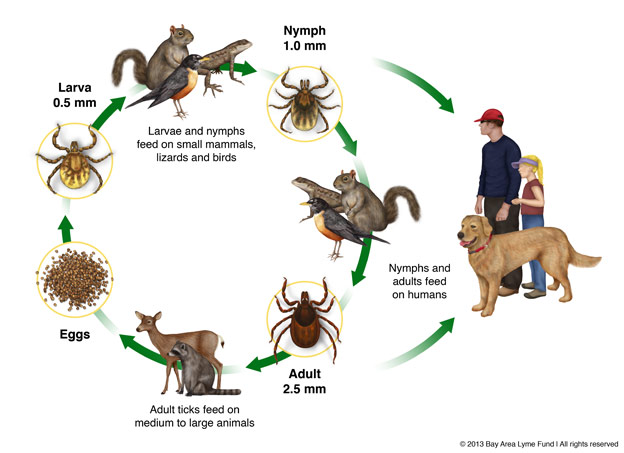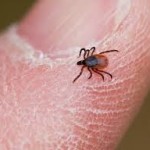Lyme disease
now browsing by tag
Afraid To Go In The Woods: Lyme Disease and Anaplasmosis

Afraid to go in the woods: Lyme disease and anaplasmosis by Terry Ryan
As I prepare for my trip up to New York for the rest of the summer, I am happy to go back to familiar sites and good friends, but I am not thrilled to be in the tick area. This year, because of perfect weather conditions for ticks, they are plentiful..
On Facebook, I have read a couple of posts from people who have been diagnosed with Lyme disease and the recovery sounds like a long, dragged out affair. The tiny little Lyme tick can infect a human by one bite; usually leaving behind a bulls-eyed rash, but not always. They symptoms can develop days or weeks later as aches and pains, fatigued, headache, and fever just to name a few irritating ones.

Treatment is a course of antibiotics, but if not caught early enough, the antibiotics can be of little effect as the disease travels to the brain causing permanent neurological symptoms.
So people feel better with treatment for a while, then the symptoms return and leave, return and leave. Ugh! Years of suffering.
After a recent phone call to a friend in upstate New York, I found out there is a new tick-transmitted disease to worry about: anaplasmosis. Her husband found two red bite marks after an afternoon of golf. One was on his back and the other on his stomach. They were red and itchy and he thought it was spider bites because they were not presenting the bulls-eyed rash. His wife applied cortisone cream for the itching.
Anaplasmosis: Use of antibiotics other than doxycycline or other tetracyclines has been associated with a higher risk of fatal outcome for some rickettsial infections. Doxycycline is most effective at preventing severe complications from developing if it is started early in the course of disease. Therefore, treatment must be based on clinical suspicion alone and should always begin before laboratory results return.
A few days later, her husband developed a fever and became so weak that he collapsed in the shower. His family took him to the emergency room where an alert M.D. suspected anaplasmosis and prescribed docxcyline even before the blood tests came back. (It proved positive for anaplasmosis a day later.)
After a couple of weeks on doxycyline, he started to feel better but he is still dealing with some of the symptoms.
I have many friends up north that have been diagnosed with Lyme disease. Most were healthy nature lovers, hikers and gardeners. People who prefer shopping in malls versus trekking through the beautiful Adirondack woods seem to have avoided the ticks.
Human anaplasmosis (HA), formerly known human granulocytic ehrlichiosis (HGE), is a bacterial disease transmitted to humans by Ixodes scapularis (blacklegged tick or deer tick), the same tick that transmits Lyme disease. The etiologic agent of HA is Anaplasma phagocytophilum, a rickettsial bacterium.
Ticks love warm, moist weather and tall grasses. They hitch rides as you pass through the grass and travel up to preferred warm areas on your body, like your upper body and ears. A Lyme tick has to bite and hang on for more than 24 hours to properly infect its host. Friends tell me they usually find them by soaping up in the shower and feel a little bump on their skin. Ticks are so tiny that a family member is called in to inspect with a magnifying glass and tick removal is done with tweezers. Another friend recently pulled a tick off her buttock, however the head was too embedded that she had to have her doctor removed the rest. The doctor did tell her that anaplasmosis is of big concern this summer.
Doctors now worry about anaplasmosis more than Lyme. Lyme is chronic, debilitating disease but usually not deadly, while anaplasmosis, the new kid on the block, can kill you in a matter of weeks.
In preparation for my trip, I started researching HOW TO PREVENT LYME DISEASE, in the form of natural and downright chemical assault. Here’s what I found:
Repel Ticks on Skin and Clothing
- Use repellent that contains 20 percent or more DEET, picaridin, or IR3535 on exposed skin for protection that lasts several hours.(Please click the highlighted letters to view the products.)
- Use products that contain permethrin on clothing. Treat clothing and gear, such as boots, pants, socks and tents with products containing 0.5% permethrin. It remains protective through several washings.
Find and Remove Ticks from Your Body
- Bathe or shower as soon as possible after coming indoors (preferably within 2 hours) to wash off and more easily find ticks that are crawling on you.
- Conduct a full-body tick check using a hand-held or full-length mirror to view all parts of your body upon return from tick-infested areas. Parents should check their children for ticks under the arms, in and around the ears, inside the belly button, behind the knees, between the legs, around the waist, and especially in their hair.
- Examine gear and pets. Ticks can ride into the home on clothing and pets, then attach to a person later, so carefully examine pets, coats, and day packs.
- Tumble dry clothes in a dryer on high heat for 10 minutes to kill ticks on dry clothing after you come indoors.
- If the clothes are damp, additional time may be needed.
- If the clothes require washing first, hot water is recommended. Cold and medium temperature water will not kill ticks effectively. If the clothes cannot be washed in hot water, tumble dry on low heat for 90 minutes or high heat for 60 minutes. The clothes should be warm and completely dry.
For pets, Advantix is what I use for my two small dogs. I apply the gel to the back of the neck and it protects against fleas and ticks. Also, there have been good reviews on the Serento collar. I was thinking about using both on my dogs but I have been advised by the veterinarian not to do that. And using the Serento collar temporarily, putting on my dogs prior to the walk and then taking it off after the walk, does not work because it takes time for the Serento collar chemicals to infiltrate the dogs body. There are, of course, versions for cats.
Even with using the above chemicals, you still have to use a flea comb and carefully examine your pets each time you come inside. Ugh!
⇒Get Paid To Take Photos!
-
- Make an extra or full-time living from your Photography!
- Work at home, make money no matter where you are in the world!
- Turn your hobby into a profitable business
- Upload and instantly sell to millions of potential buyers
- Receive payments via paypal, wire transfer or mailed checks
- Grab your camera and start a high-paying career in photography today!
- 7 Day Free Trial
- CLICK HERE!!!!!!
There are treatments for your yard to control ticks: keeping brush down, building a stone perimeter around your yard so ticks will be less likely to venture unto your grass. And there are chemical treatments that a homeowner can apply directly to their lawn, however, there are questions on how long do they work and do you want your children playing on a chemical soaked lawn?
Here are some products if you want to treat your lawn for ticks:
Where did all the BAD ticks come from?
If you wondering why you were once able to run wild and free through grassy fields and never have to worry about being bitten and poisoned by a tick, that’s a good question. Never as a child did my mother have to examine my body every time I came in from playing in the park next door. Thank GOD!
Is it a governmental scientific experiment that went wrong?! There is an island off the tip of Long Island, Plum Island, that is a animal disease lab and some people say that is where the Lyme tick originated.
In 1954 the United States Department of Agriculture (USDA) established the Plum Island Animal Disease Center (PIADC). The Center conducts research on animal pathogens to protect farmers, ranchers, and the national food supply. Because of the nature of the research, access to the Island and the research facility is restricted.
Conspiracy theorists theorize that the US government was experimenting with making infectious ticks to create dirty bombs for biological warfare. Biological warfare has been used for centuries. White settlers gave native Americans blankets infected with the small pox disease thereby wiping out entire tribes.
Japan and Biological Warfare
Unit 731 was specifically created by the Japanese military in Harbin which was then located in Japanese-occupied Manchukuo for researching biological and chemical warfare which they carried out human experimentation on men, women, children, and infants, regardless of whether they were captives or warfare casualties. During the Second Sino-Japanese War and later World War II, the Japanese had encased bubonic plague, cholera, smallpox, botulism, anthrax, and other diseases into bombs where they were routinely dropped on Chinese combatants and non-combatants. According to the 2002 International Symposium on the Crimes of Bacteriological Warfare, the number of people killed by the Imperial Japanese Army germ warfare and human experiments is around 580,000.[1] According to other sources, “tens of thousands, and perhaps as many as 400,000 Chinese died of bubonic plague, cholera, anthrax and other diseases” from the use of biological warfare.[2]
During the first few months at war with the United States following the attack on Pearl Harbor, Japan also had previously planned to use biological weapons against Americans. During the Battle of Bataan in March 1942, the Japanese considered releasing 200 pounds of plague-carrying fleas—about 150 million insects—in each of ten separate attacks. However, the surrender of American forces rendered the plan unnecessary. In early July 1944 during the Battle of Saipan, when the war was going against Japan, plague-infested fleas were again intended to be used against American combatants. However, the Japanese submarine carrying the fleas was sunk by the American submarine Swordfish off Chichi Jima.
Back to Plum Island…
The theory is, ticks were infected with bacterium Borrelia burgdorferi at the lab, then the ticks escaped and guess where they first showed up? Right across the bay in Lyme, Connecticut. Now they are rapidly spreading across the US and the Northeast is a hot spot.
How many people are infected with Lyme Disease?
300,000 people per year!
If you are interested in learning more about Plum Island’s mysterious operations, check out the book LAB 257: The Disturbing Story of the Government’s Secret Germ Laboratory.
AND THERE IS MORE THAN LYME AND ANAPLAMOSIS…POWASSAN!!!!!
http://www.cnn.com/2017/05/03/health/powassan-tick-virus/index.html
Powassan is a rare tick-borne disease caused by a virus. It can cause swelling in the brain (doctors call this encephalitis) and in the membranes around the brain and spinal cord (you may hear this called meningitis).
Though rarer than Lyme disease it is spreading and it is deadly.
Conclusion:
Stay out of areas where ticks thrive.
If you do hike or garden, then use a spray that contains DEET.
Take a shower after being outside in 2 hours and check for ticks.
If you suspect a tick has bitten you, go to your doctor.
Stay safe!
Protect Yourself From Lyme Disease

 What is Lyme disease? Lyme disease is an infection caused by a spirochete that humans can get from the bite of an infected deer tick. The spirochete’s scientific name is Borrelia burgdorferi.
What is Lyme disease? Lyme disease is an infection caused by a spirochete that humans can get from the bite of an infected deer tick. The spirochete’s scientific name is Borrelia burgdorferi.
It was first discovered in Lyme, Connecticut a quaint little town with a population of around 2k. In the early 1970s a group of children and adults in Lyme, Connecticut, and the surrounding areas were suffering from some puzzling and debilitating health issues. Their symptoms included swollen knees, paralysis, skin rashes, headaches, and severe chronic fatigue. Visits with doctors and hospital stays had become all too common.
Physicians began to study the group’s symptoms and looked for several possible causes. What was causing all these debilitating symptoms? What added to the mystery were the reported skin rashes followed very quickly by arthritic conditions. Most of the people recalled being bitten by a tick in the region. Residents of Lyme began calling it Lyme disease, but they still didn’t know what caused it.
In 1981, a scientist, Willy Burgdorfer, who was studying Rocky Mountain Spotted Fever (also caused by a tick bite) began to study Lyme disease. He found the connection between the deer tick and the disease and gave the bacteria causing the illness a name, Borrelia burgdorferi. Therefore, antibiotic treatment could be used to “eradicate” the disease.
This treatment is currently accepted by the medical profession and has been largely successful, especially for those with early-stage Lyme disease. However, there continues to be heavy debate on the long-term use of antibiotics for Lyme that has progressed or appears resistant to a short course of antibiotics.
In 2012, Lyme disease was included as one of the top ten notifiable diseases by the Centers for Disease Control and Prevention (CDC).
Lyme disease is one of the fastest-growing infections in the United States. The CDC estimates that there are 300,000 new cases of Lyme disease each year here in the US. While it was primarily an East Coast phenomenon in the beginning, it has since been reported in all states except Hawaii. (Note: I now live in Sarasota, FL and my veterinarian has told me we do not have Lyme disease in Sarasota, YET. This was after I ran to the veterinarian’s after finding a small tick on my dog.)
I recall when the first time I saw a person with Lyme Disease (20 years ago). I was living in Upstate NY and had met her through some friends. She was obviously physically ill, could hardly walk, and just returned from Mexico were she had undergone an experimental treatment for Lyme disease. It was sad to see, shocking really, and she was exhausted and went home as the rest of us escorted her husband to dinner. I wonder if she is still alive as that was the only time I ever saw her, and her condition was terrible.
As the years went on, I would hear of more and more friends and acquaintances having brushes with Lyme disease. Stories of picking nasty ticks off of body parts after hikes in the woods, a dentist hooked up to an IV of antibiotics as he continued to work on patient’s teeth, or a business man who could no longer run his business because of the disease, continued to send terror into our community.
Now it is 2015, and people are afraid to walk in the woods, garden in their yards, or let their kids play soccer in fear they will pick up a deer tick. And pets are not immune. My friend’s dogs have had Lyme disease, however there is now a vaccination for dogs but not available for humans.
Why were we able to play outside as children and never worried about being infected with Lyme disease? Is it the result of a scientific experiment gone haywire? According to the website http://nstarzone.com/LYME.html it was the US government that created Lyme disease. Their conspiracy theory is that a scientist was experimenting by infecting ticks with a deadly disease as part of biological warfare on Plum Island outside of Long Island and only 10 miles from Lyme, Connecticut. Hmmmm
The History of Plum Island CLICK HERE
Some scientists say that Lyme disease has been around for years and it is just taking this long to spread to your particular area. A German physician, Alfred Buchwald, first described the chronic skin rash, or erythema migrans, of what is now known to be Lyme disease more than 130 years ago.
Here are some precautions to take to prevent YOU from being infected with Lyme disease:
- Wear white clothing so you can see the ticks and tuck pants into socks when you go for hikes.
- Stay on sidewalks and roads. Ticks like grassy areas.
- Stand in front of a mirror and examine yourself front and back after being outside doing lawn care or gardening. etc.
- Consider DEET for skin and PERMETHRIN for your clothes. A single application of permethrin to your clothing can provide up to six weeks of protection, even after repeated washings. LEMON EUCALYPTUS OIL is believed to repel ticks and several all-natural organic sprays now exist on the market.
- Check your dogs and cats for ticks when they come into the house.
- You can try making your own tick repellant: (I’m not sure how well it works.)
- 12 drops lemongrass
- 6 drops eucalyptus
- 2 drops citronella
How to remove a tick:
- Use fine-tipped tweezers to grasp the tick as close to the skin’s surface as possible.

- Pull upward with steady, even pressure. Don’t twist or jerk the tick; this can cause the mouth-parts to break off and remain in the skin. If this happens, remove the mouth-parts with tweezers. If you are unable to remove the mouth easily with clean tweezers, leave it alone and let the skin heal.
- After removing the tick, thoroughly clean the bite area and your hands with rubbing alcohol, an iodine scrub, or soap and water.
- Dispose of a live tick by submersing it in alcohol, placing it in a sealed bag/container, wrapping it tightly in tape, or flushing it down the toilet. Never crush a tick with your fingers.
Symptoms of Lyme disease:
- A flu-like feeling
- Joint aches and pains
- Rash around the site of the tick bite
- Fever
- Sore throat
- A constant headache
- Depression
- Exhaustion
Most people that develop Lyme disease never develop the classic bulls-eyed rash.
Most people with Lyme disease never test positive for Lyme in early blood test.
A small percentage of people are NOT CURED with antibiotics.
It is important to get treatment as soon as possible if you suspect your were bitten by a deer tick. If Lyme disease is not diagnosed and treated early, the Lyme spirochetes can spread and may go into hiding in your body. Weeks, months or even years later you may have problems with your brain and nervous system, muscles and joints, heart and circulation, digestion, reproductive system, and skin. Symptoms may disappear even without treatment and different symptoms may appear at different times.
The most common  antibiotics prescribed for Lyme Disease is amoxicillin, doxycycline, tetracycline and penicillin. The length of antibiotic treatment varies according to how bad the disease and your symptoms are, but treatment generally lasts less than 4 weeks.
antibiotics prescribed for Lyme Disease is amoxicillin, doxycycline, tetracycline and penicillin. The length of antibiotic treatment varies according to how bad the disease and your symptoms are, but treatment generally lasts less than 4 weeks.
What happens if you do not get better with treatment?
Chronic Lyme disease happens when a person does not seek treatment in time or does not adequately respond to standard antibiotic treatment. Usually your doctor will prescribe more antibiotics or a course of IV antibiotics. Each patient’s case is different.
In the case with the woman I met 20 years ago, she was not responding well with conventional therapy and chose an alternative medical treatment in Mexico. You can Google alternative treatment centers for more info but make sure you do your research before spending your money.
Spring is coming and that means the ticks will come out of hiding. Be careful when you are outside and stay tick-free!
Thanks for reading!
Terry Ryan, Blogger
Terry Ryan is a website designer, social media expert and blogger. She lives in Sarasota, FL. http://www.internetboomer.com







 D5 Creation
D5 Creation